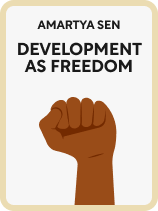

This article is an excerpt from the Shortform book guide to "Development as Freedom" by Amartya Sen. Shortform has the world's best summaries and analyses of books you should be reading.
Like this article? Sign up for a free trial here .
Why do women need to have a well-rounded education? How does a woman’s education affect child mortality and fertility rates?
Giving women the right to education has many benefits. They can get a better job and make more money, thus increasing their income. They’ll also be more aware of family planning techniques, which allows them to take better care of children or not have children at all.
Check out Amartya Sen’s view on the importance of female education, explained in his book Development as Freedom.
Female Education, Workforce, and Child Welfare
Sen argues that the most effective way to empower women is to increase literacy. Research shows that increases in female literacy are strongly associated with a reduction in child mortality. This is a major factor in the importance of female education because the knowledge women gain through education allows them to better care for their children.
In addition to reducing overall child mortality, female literacy (and female labor force participation) is also associated with closing the gap in mortality rates between boys and girls.
Other factors, such as male literacy and urbanization, weren’t associated with such reductions. This dynamic highlights Sen’s point that traditional methods of development don’t always lead to the desired results.
In this case, overall economic development was not enough to reduce child mortality, but women’s literacy was. For example, one study in India showed that a 50% reduction in the overall poverty rate made almost no difference in under-5 child mortality rates, but an increase in female literacy from 22% to 75% reduced child mortality rates from 156 per thousand births to 110 per thousand births.
Female Education and Fertility Rates
The importance of female education and labor force participation have a similar positive effect on fertility rates. Around the globe, according to Sen, a greater recognition of women’s rights usually leads to a reduction in fertility rates (the average number of children born per woman).
In many developing societies, women have little choice in family planning. Education gives women greater knowledge about family planning, and work outside the home often gives them more options, too.
Advances in Female Literacy, Reductions in Fertility Rates
Since Development as Freedom was published in 2000, women’s literacy rates have continued to improve. In 2000, female literacy in the Least Developed Countries (LDCs, as classified by the United Nations) was 44%. As of 2020, it has risen to 59%. School enrollment is up for girls, and literacy rates among young women in poor countries are nearly on par with those of young men.
A similarly positive trend has happened to women’s average number of births. In 2000, the fertility rate in LDCs was 5.2. In 2020, it was down to 3.9. Sen would likely attribute this reduction to female educational empowerment, greater recognition of women’s rights in family planning, and increased access to contraception. Also, improved health care has helped reduce infant mortality, which allows women to bear fewer children to achieve their desired family size. This provides more evidence that coercive population control measures are not needed to cut fertility rates.

———End of Preview———
Like what you just read? Read the rest of the world's best book summary and analysis of Amartya Sen's "Development as Freedom" at Shortform .
Here's what you'll find in our full Development as Freedom summary :
- The five types of freedom that are integral to economic development
- How democracy can prevent famine
- How empowering women helps communities






